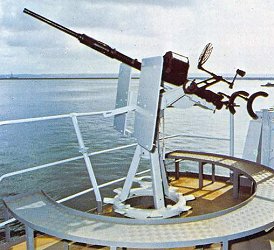
Back 20 mm оръдие Oerlikon Bulgarian 20mm kanón Oerlikon Czech 20-mm-Oerlikon-Kanone German Oerlikon 20 mm Spanish Oerlikon 20 mm Estonian توپ ۲۰ میلیمتری اورلیکن Persian Oerlikon 20 mm Finnish Canon de 20 mm Oerlikon French תותח אורליקון HE Meriam Oerlikon 20 mm ID
| Oerlikon 20 mm cannon | |
|---|---|
 Oerlikon 20 mm cannon in French service | |
| Type | Autocannon |
| Place of origin | Switzerland |
| Service history | |
| In service | 1937–present |
| Used by | Various |
| Wars | World War II, various |
| Production history | |
| Designer | Reinhold Becker |
| Designed | 1935 |
| Manufacturer | Oerlikon |
| Produced | 1937– |
| No. built | 124,734[1] |
| Variants | Oerlikon FF MG FF cannon |
| Specifications | |
| Mass | L70 Total gun barrel weight: 68.04 kilograms (150.0 lb) Minus breech mechanism: 20.865 kg (46.00 lb) L85 Empty: 92.0 kilograms (202.8 lb) Loaded with 200 rounds: 182.0 kg (401.2 lb) |
| Length | L70 Overall: 2,210 mm (87 in) Barrel length: 1,400 mm (55 in) L85 Overall: n/a Barrel length: 1,700 mm (67 in) |
| Shell | L70: 20×110mmRB L85: 20×128mm |
| Shell weight | HE: 123 g (4.3 oz) HE/T: 116 g (4.1 oz) |
| Caliber | 20 mm (0.787inch) |
| Barrels | Single barrel (progressive RH parabolic twist, 9 grooves) |
| Action | API blowback |
| Elevation | Manual, -15°/+90° |
| Traverse | Manual, full 360° |
| Rate of fire | L70: Cyclic: 450 rounds per minute Practical: 250-320 rounds per minute L85: Cyclic: 900 to 1,000 rounds per minute |
| Muzzle velocity | L70: 820 m/s (2,700 ft/s) L85: 1,050 m/s (3,400 ft/s) |
| Effective firing range | Against low-flying aircraft (HE round) L70: 914 m (1,000 yd) L85: 1,500 m (1,600 yd) |
| Maximum firing range | HE round at 45° L70: 4,389 m (4,800 yd) L85: 6,800 m (7,400 yd) |
| Feed system | Cylindrical magazine holding 60 rounds, Later adjusted to be a belt fed gun |
The Oerlikon 20 mm cannon is a series of autocannons based on an original German Becker Type M2 20 mm cannon design that appeared very early in World War I. It was widely produced by Oerlikon Contraves and others, with various models employed by both Allied and Axis forces during World War II. Many versions of the cannon are still used.[2][3]
- ^ Budge, Kent G. (2014). "20mm Oerlikon Light Antiaircraft Gun". The Pacific War Online Encyclopedia. Retrieved 30 May 2019.
- ^ "Switzerland Oerlikon 20 mm/70 (0.79") Mark 1"". NavWeaps.com. 14 January 2011. Retrieved 24 September 2011.
- ^ "Britain 20 mm/85 (0.79") GAM-BO1". NavWeaps.com. 21 June 2008. Retrieved 23 October 2011.